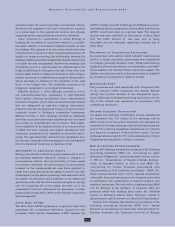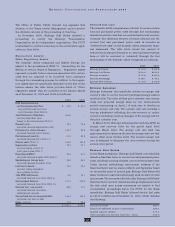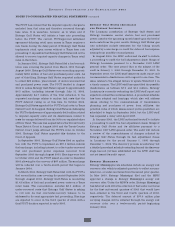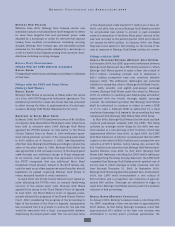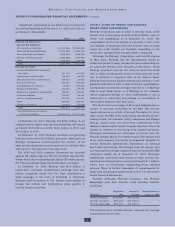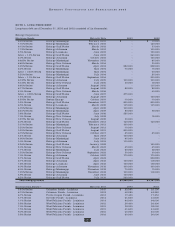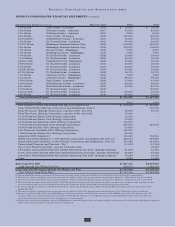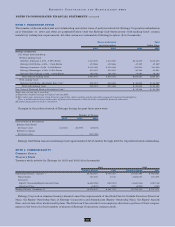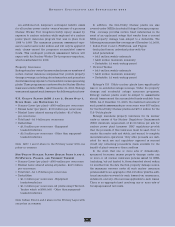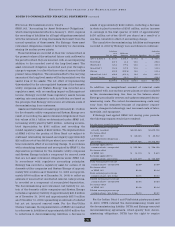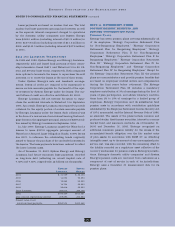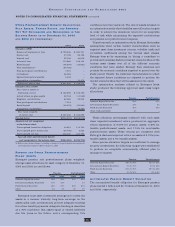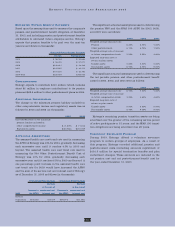Entergy 2003 Annual Report Download - page 73
Download and view the complete annual report
Please find page 73 of the 2003 Entergy annual report below. You can navigate through the pages in the report by either clicking on the pages listed below, or by using the keyword search tool below to find specific information within the annual report.
71
ENTERGY CORPORATION AND SUBSIDIARIES 2003
The annual long-term debt maturities (excluding lease
obligations) for debt outstanding as of December 31, 2003,
for the next five years are as follows (in thousands):
2004 2005 2006 2007 2008
$503,215 $462,420 $75,896 $624,539 $941,625
In November 2000, Entergy’s Non-Utility Nuclear busi-
ness purchased the FitzPatrick and Indian Point 3 power
plants in a seller-financed transaction. Entergy issued notes
to New York Power Authority (NYPA) with seven annual
installments of approximately $108 million commencing
one year from the date of the closing, and eight annual
installments of $20 million commencing eight years from
the date of the closing. These notes do not have a stated
interest rate, but have an implicit interest rate of 4.8%. In
accordance with the purchase agreement with NYPA, the
purchase of Indian Point 2 resulted in Entergy’s Non-Utility
Nuclear business becoming liable to NYPA for an additional
$10 million per year for 10 years, beginning in September
2003. This liability was recorded upon the purchase of
Indian Point 2 in September 2001, and is included in the
note payable to NYPA balance above. In July 2003, a
payment of $102 million was made prior to maturity on
the note payable to NYPA. Under a provision in a letter of
credit supporting these notes, if certain of the domestic
utility companies or System Energy were to default on
other indebtedness, Entergy could be required to post
collateral to support the letter of credit.
Covenants in the Entergy Corporation notes require it to
maintain a consolidated debt ratio of 65% or less of its total
capitalization. If Entergy’s debt ratio exceeds this limit, or if
Entergy or certain of the domestic utility companies default
on other indebtedness or are in bankruptcy or insolvency
proceedings, an acceleration of the notes’ maturity dates
may occur.
CAPITAL FUNDS AGREEMENT
Pursuant to an agreement with certain creditors, Entergy
Corporation has agreed to supply System Energy with
sufficient capital to:
maintain System Energy’s equity capital at a minimum
of 35% of its total capitalization (excluding short-term
debt);
permit the continued commercial operation of Grand
Gulf 1;
pay in full all System Energy indebtedness for borrowed
money when due; and
enable System Energy to make payments on specific
System Energy debt, under supplements to the
agreement assigning System Energy’s rights in
the agreement as security for the specific debt.
NOTE 6. COMPANY-OBLIGATED REDEEMABLE
PREFERRED SECURITIES
Entergy implemented Financial Accounting Standards
Board (FASB) Interpretation No. 46, “Consolidation of
Variable Interest Entities” effective December 31, 2003. FIN
46 requires existing unconsolidated variable interest
entities to be consolidated by their primary beneficiaries if
the entities do not effectively disperse risks among their
investors. Variable interest entities (VIEs), generally, are
entities that do not have sufficient equity to permit the
entity to finance its operations without additional financial
support from its equity interest holders and/or the group of
equity interest holders are collectively not able to exercise
control over the entity. The primary beneficiary is the party
that absorbs a majority of the entity’s expected losses,
receives a majority of its expected residual returns, or both
as a result of holding the variable interest. A company may
have an interest in a VIE through ownership or other
contractual rights or obligations.
Entergy Louisiana Capital I, Entergy Arkansas Capital I,
and Entergy Gulf States Capital I (Trusts) were established
as financing subsidiaries of Entergy Louisiana, Entergy
Arkansas, and Entergy Gulf States, respectively, (the parent
company or companies, collectively) for the purposes of
issuing common and preferred securities. The Trusts issued
Cumulative Quarterly Income Preferred Securities
(Preferred Securities) to the public and issued common
securities to their parent companies. Proceeds from such
issues were used to purchase junior subordinated
deferrable interest debentures (Debentures) from the parent
company. The Debentures held by each Trust are its only
assets. Each Trust uses interest payments received on the
Debentures owned by it to make cash distributions on the
Preferred Securities and common securities. The parent
companies fully and unconditionally guaranteed payment
of distributions on the Preferred Securities issued by the
respective Trusts. Prior to the application of FIN 46, each
parent company consolidated its interest in its Trust.
Because each parent company’s share of expected losses of
its Trust is limited to its investment in its Trust, the parent
companies are not considered the primary beneficiaries and
therefore de-consolidated their interest in the Trusts upon
application of FIN 46 with no significant impacts to the
financial statements. The parent companies’ investment in
the Trusts and the Debentures issued by each parent company
are included in Other Property and Investments and Long-
Term Debt, respectively. The financial statements as of
December 31, 2002 have been reclassified to reflect the appli-
cation of FIN 46 as of that date.


